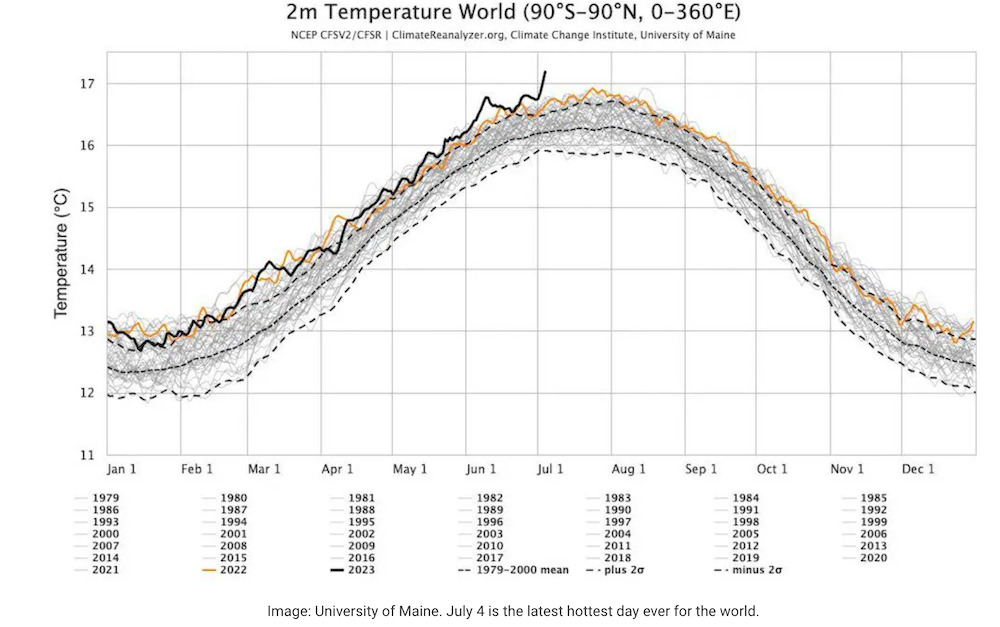The Ethical Investor: If not now, when? Earth’s hottest day on record signals call to action for ESG investors

The hottest day on record calls for immediate action for ESG investors. Picture Getty
- The hottest day on record calls for immediate action
- Expert says that every investor now has a responsibility to consider ESG investments
- The opportunities to play the climate change theme are enormous for Aussie investors
Monday, July 3 was the hottest day ever recorded on Planet Earth.
A record that lasted until… Tuesday, July 4. That was when the global average temperatures hovered above 17 degrees Celsius for the first time ever, reaching 17.18C.
The previous record was 16.92C, posted on August 4, 2016.

Should we care? Yes, and it’s a milestone we shouldn’t be particularly celebrating either.
“It’s a death sentence for people and ecosystems,” said Friederike Otto, a senior lecturer at the Grantham Institute for Climate Change and the Environment.
Hot weather has caused heatwaves in parts of China and India this summer, and experts warned that higher temperatures will exacerbate health problems as humans aren’t used to it.
Hotter weather is also expected to have further adverse impact on the world’s already fragile food security problem.
It’s a worrying sign for the agricultural sector, more so as the Australian Bureau of Meteorology (BOM) is already predicting a 50% chance of El Niño weather later this year.
Over the past three months, the Murray-Darling Basin has seen an average to below average rainfall, which is consistent with the chance of drier El Niño conditions later in the year.
A call to action for ESG investors
Experts from the financial industry have chimed in, saying that the record temperature must act as a wake-up call that more must urgently be done to battle human-driven environmental issues.
“The hottest day ever recorded globally tells investors now is the time to consider putting your money to work for both profits and positive change. If not now, when?” said Nigel Green, CEO of deVere Group.
“I believe that every investor now has a responsibility to consider ESG investments.”
Green added that the environmental and social impact you can have with ESG investments is not the only reason why you should consider them as part of your portfolio.
“Numerous studies have demonstrated that companies with strong ESG practices tend to outperform their peers over the long term.
“By incorporating ESG investments, investors have the opportunity to participate in the growth of companies that are well-positioned to navigate risks, capitalise on emerging opportunities, and drive sustainable innovation,” noted Green.
Green also said the global regulatory landscape is evolving, and investors who proactively integrate ESG investments into their portfolios can navigate regulatory changes more effectively and position themselves for future market shifts.
“Plus, as ESG considerations become mainstream, investments in companies with strong ESG profiles are likely to attract more attention from institutional and individual investors.
“All of the reasons and all the evidence suggest that ESG-focused investors can achieve both profitability and positive impact,” Green said.
Battery stock opportunities on the ASX
There are two common approaches Aussie investors can follow to adjust their portfolios in response to climate change.
The first is based on reducing investments in stocks associated with climate change by avoiding exposure, for example, to highly polluting industries.
The second is to consider climate change as an investment opportunity, and look for companies that will benefit from the transition to a low carbon economy.
A key sector that’s truly racing ahead towards net zero is the electric cars (EV) industry. One way an investor could benefit from this is by positioning their portfolio towards battery metal and mineral stocks.
In the large end of town, this could be stocks such as Liontown Resources (ASX:LTR), BHP (ASX:BHP) or Rio Tinto (ASX:RIO).
On the smaller end of town, there are stocks which play well to the battery supply theme, including:
MAGNIS ENERGY TECHNOLOGIES (ASX:MNS)
Graphite developer Magnis has locked in a deal with Tesla for the supply of a minimum 17,500tpa of active anode material (AAM) beginning in February 2025 for a minimum term of three years with fixed pricing.
Magnis has also fulfilled one of the key conditions of the deal by securing the location of the commercial AAM facility in the southwest of the US – chosen from amongst the sites undergoing an advanced review along with shortlisted sites in the Midwest and Southeast regions.
European Lithium signed a binding long term offtake agreement with BMW for battery grade lithium hydroxide (LiOH) from its Wolfsberg Lithium project in Austria.
Development path of the Wolfsberg lithium project in Austria is clearing after Critical Metals Corp (CRML) entered into a US$125m share subscription facility with GEM Global Yield.
CRML is the proposed merger between the company’s wholly owned subsidiary European Lithium AT, which holds the Wolfsberg project in Austria, and Sizzle Acquisition Corp (Nasdaq:SZZL).
QUEENSLAND PACIFIC METALS (ASX:QPM)
QPM has entered into a binding equity subscription agreement and offtake agreement with General Motors in October 2022 to form the beginning of a “long-term strategic collaboration”.
The Qld government is supporting QPM’s Townsville Energy Chemicals Hub (TECH) nickel-cobalt project and battery metals refinery, announcing in March that TECH had received Significant Investment Project status.
That was possibly spurred on by the fact that the company nabbed an offtake deal with EV car maker General Motors last year to purchase all uncommitted nickel and cobalt sulphate produced in the first 15 years of Phase 1 of the TECH Project.
Under the deal, GM agreed to investment up to US$69m in equity in QPM including an initial binding commitment of US$20.1mn at $0.18 per share.
Ioneer has a deal with Ford that includes the supply of 7,000tpa of lithium carbonate over a five-year term from its Rhyolite Ridge lithium-boron project in Nevada, starting in 2025.
INR also has a three-year offtake agreement with energy storage company Dragonfly Energy Holdings for surplus tonnes available after meeting its other offtake commitments.
The company is also benefiting through funding, in January securing a loan up to US$700 million from the US Department of Energy (DOE) as part of the US drive to achieve long-term critical mineral supply chain security.
Phase 1 drilling has proven that Lord’s Horse Rocks project in WA is within a fractionated lithium-caesium-tantalum system with anomalous intercepts at shallow depths.
Lord is currently carrying out a structural review of Horse Rocks – including updating the magnetic and radiometric geophysical dataset – to assist with targeting the next phase of deep drilling.
Phase 2 drilling anticipated to begin in Q3 to test highly fractionated pegmatites at depth.
MinRex currently holds five projects, four in the East Pilbara area of WA – the Daltons Gold Project, the Bamboo Creek Gold Project, the Marble Bar North Gold Project and the Marble Bar South Gold Project – as well as the Deflector Extended Gold Project at Gullewa in WA.
The company has also cast its net overseas and secured an exclusive option to acquire the Tancred lithium project in Ireland’s Leinster lithium-caesium-tantalum pegmatite belt.
Tancred consists of four granted exploration licences covering 249km2 with a strike length of about 20km and was identified as an area of anomalous geochemistry from regional rock and stream sediment datasets.
Share prices today:
Renewable energy opportunities on the ASX
In the renewable energy space, these hydrogen companies play an important piece of the global net zero emission by 2050 puzzle.
Gold Hydrogen seeks to play a significant role in the low-carbon energy push by commercialising naturally occurring hydrogen.
The company is sitting on a very large natural hydrogen prospective resource with plans for low-cost production.
GHY is focused on starting planned exploration activities for 2023, and this includes working closely with world leading experts Schlumberger, CSIRO, Xcalibur and Total Seismic in undertaking soil surveys, airborne gravity magnetic surveys and drilling for natural hydrogen based on historical occurrences.
Frontier’s Bristol Springs Project is on track to become one of the first commercial scale green hydrogen operations in Australia.
The project is very mature compared to others in the industry, with all engineering complete, permits and approvals in place.
“By far our biggest advantage is that all major associated infrastructures is already in place, allowing for significant cost saving and time to production compared to more remote projects,” said CEO, Sam Mohan.
“This means we can produce green hydrogen at a highly competitive price of just $2.83/kg.”
HyTerra is the first ASX listed company focussed on the exploration and production of natural hydrogen.
The company has an earn-in interest in a joint development with Natural Hydrogen Energy LLC which includes the world’s first wildcat well targeting natural hydrogen in Nebraska, USA.
HyTerra recently announced that it has successfully executed an airborne gravity and magnetic geophysical survey over the company’s Nemaha Ridge leases and the surrounding areas.
Operation was safe and efficient, with critical data ready for interpretation this month.
Share prices today:
At Stockhead we tell it like it is. While MNS, EUR, QPM, LRD, MRR, GHY, FHE, and HYT are Stockhead advertisers, they did not sponsor this article.
Related Topics
UNLOCK INSIGHTS
Discover the untold stories of emerging ASX stocks.
Daily news and expert analysis, it's free to subscribe.
By proceeding, you confirm you understand that we handle personal information in accordance with our Privacy Policy.








